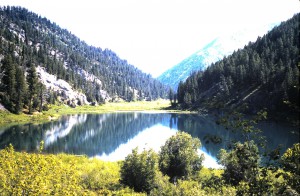Palisades Creek

Lower Palisades Lake and Creek Above
A while back we took a look at Big Elk Creek. In a number of ways it and Palisades Creek are physically similar, and some of the comments made for Big Elk apply to Palisades Creek with respect to fishing. But there are also major differences when comparing these two first class fisheries.
First; whereas Big Elk Creek empties into Palisades Reservoir, Palisades Creek empties into the South Fork reach of the Snake River below Palisades Dam. It is reached from U. S. Highway 26 where its access road goes roughly northeast leaving the highway about four miles below the dam. Within two miles the access road enters Caribou-Targhee National Forest where a full-service campground provides a base for fishing the creek or neighboring waters during an overnight or multi-day stay. The trail head for accessing the creek is above the campground on the opposite side and has ample parking. The trail from which the creek is mostly easily accessed is well maintained and non-motorized being open to mountain bike, horse, and foot traffic.
Through emptying into the river, Palisades Creek is a major spawning stream for cutthroat trout. Idaho Department of Fish and Game, as part of efforts to enhance cutthroat trout populations, operates a fish trap on the lower creek. Here cutthroat trout are allowed to pass to upstream spawning areas, and rainbow trout are denied access. Harvest of cutthroat trout is denied in Palisades Creek, and it is closed to fishing yearly during the month of June, all to minimize disturbance to this native salmonid while spawning. There is no harvest limit on rainbow and trout hybrids within the creek during fishing season.
The best fishing throughout Palisades Creek begins after run-off leaves, and dry fly fishing can be most enjoyable. It’s a stream of some gradient from lower Palisades Lake downstream, so most trout there will occupy holes, deeper runs, and just below structure. Access at some places as well as an uninterrupted back cast, can be a challenge because of willow thickets, but the creek is small enough that it can be safely waded and crossed in a number of places after run-off leaves. During summer months wet wading is practical. Light-weight gear makes playing trout in the fast water fun, so three and four weight systems are ideal. Trout here range up to moderate sizes with an occasional individual reaching trophy size. Caddisflies and stoneflies are the major aquatic insects present, so life cycle fly patterns for them are usually effective. So are traditional attractor patterns, dry and wet. Mayflies including PMDs, BWOs, and flavs are present but are relatively minor. As mid-summer approaches terrestrial insects become abundant along stream banks adding another interesting dimension to dry fly fishing in fast water.
Here’s another way Palisades Creek differs from others in the South Fork-Palisades Reservoir drainage. Two major lakes, Lower and Upper Palisades lake are within its drainage. The upper lake, on a tributary, has a subterranean outlet, and much of the outflow from the lower lake, on the creek itself, is also subterranean. This flow helps keep good water level in the creek during dry weather periods. The lower lake is a bit over four miles by trail above the campground, and some of the best fishing on the creek is in the low gradient stretch just above the lake. Because of beaver channels, willows, and marshy areas moving around here can be a challenge. But doing so is rewarding because the trout here average larger than in the fast water below the lake.
So Palisades Creek is another stream that offers great fishing, an easy approach, and solitude. Its trail is non-motorized so its tranquility means the only noise is the creek itself.

